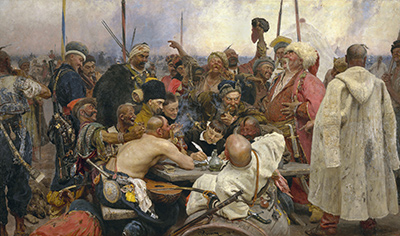The Russuan artist, Ilya Repin painted the Reply of the Zaporozhian Cossacks in 1880-91.
The full name is that of, Reply of the Zaporozhian Cossacks to Sultan Mehmed IV of the Ottoman Empire. The canvas measures a staggering 3 metres by 2.5 metres. The painting was originally bought by Alexander III at the cost of 35,000 rubles. This was to be the largest amount paid for any painting by a Russian artist at that time. In 1932 the painting was given to the Kharkiv Historical Museum. Then during 1935 it transferred to Saint Petersburg at the State Russian Museum, where it is still housed today.
This oil on canvas creation took eleven years to complete and is widely believed to be a historically based tableau of the Cossack legend from 1676. The legend is that of the Cossacks writing a letter of reply to the Sultan of the Ottoman Empire, Mehmed IV, who had issued an ultimatum that they should all surrender to him. Historians do not know if the reply existed, nor what was written in the letter.
During the 1870s Ya. Novitsky, who was an amateur ethnographer, was believed to have found a copy of the letter. This letter was then passed onto Dmytro Yavornytsky, who was a historian. It was while he was entertaining guests that he decided to read the letter to them, with one such guest being that of Ilya Repin. This piqued the painter's curiosity and so began the painting in 1880. It was during the latter years of painting the Reply of the Zaporozhian Cossacks, that Repin began to paint a second version, this was in 1889. He wanted this second version to be more historically correct. Sadly, he never finished this painting. The painting is extremely busy with lots of action and people to observe. It does appear that the Cossacks are in good spirits and enjoying each other's company.
The air seems to be infused with that of mocking the sultan with defiance about any notion of surrender. During the time of this painting, the Cossacks were of Ukranian nationality, and were also of the Calvary, issued to protect the borders of Turkey by the orders of Poland. The most notorious settlement was that of Zaporogian situated along the Dniepr River. It was during 1675 that Poland was forced to surrender such areas as Zaporogian, something that the Cossacks were vehemently opposed to doing. This is why many historians believe that the letter of defiance was written during this period. Many of the men featured in the painting were known to Repin, and agreed to model for him. An old man, who's son was a friend of Repin's happily obliged to pose for the role of scribe.
Another ancient story tells that Repin spotted a general and wanted to paint his bald head. When he asked the general if he would pose for him, he was told no. Repin found out that the general liked to collect ancient coins, and so quickly acquired some. When he called at the general's home to show him he coins, while the general was bent down inspecting them, Repin quickly drew the general's head. After the completion of the Reply of the Zaporozhian Cossacks, Repin became one of the most famous painters in Russia. Repin was a Jew, and as such, many of his fellow artists and contemporaries did but take this news too well.




